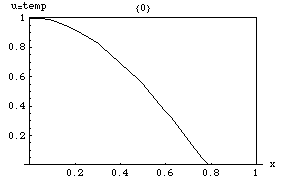Heat equation
来源:互联网 发布:ipad钢琴教学软件 编辑:程序博客网 时间:2024/04/30 03:30
转自:http://en.wikipedia.org/wiki/Heat_equation
Heat equation
The heat equation is a parabolic partial differential equation which describes the distribution of heat (or variation in temperature) in a given region over time.

In this example, the heat equation in two dimensions predicts that if one area of an otherwise cool metal plate has been heated, say with a torch, over time the temperature of that area will gradually decrease, starting at the edge and moving inward. Meanwhile the part of the plate outside that region will be getting warmer. Eventually the entire plate will reach a uniform intermediate temperature. In this animation, both height and color are used to show temperature.
Statement of the equation
For a function u(x,y,z,t) of three spatial variables (x,y,z) (see cartesian coordinates) and the time variable t, the heat equation is
More generally in any coordinate system:
where α is a positive constant, and Δ or ∇2 denotes the Laplace operator. In the physical problem of temperature variation, u(x,y,z,t) is the temperature and α is the thermal diffusivity. For the mathematical treatment it is sufficient to consider the case α = 1.
The heat equation is of fundamental importance in diverse scientific fields. In mathematics, it is the prototypicalparabolic partial differential equation. In probability theory, the heat equation is connected with the study of Brownian motion via the Fokker–Planck equation. In financial mathematics it is used to solve the Black–Scholes partial differential equation. The diffusion equation, a more general version of the heat equation, arises in connection with the study of chemical diffusion and other related processes.
General description
Suppose one has a function u which describes the temperature at a given location (x, y, z). This function will change over time as heat spreads throughout space. The heat equation is used to determine the change in the function u over time. The image to the right is animated and describes the way heat changes in time along a metal bar. One of the interesting properties of the heat equation is the maximum principlewhich says that the maximum value of u is either earlier in time than the region of concern or on the edge of the region of concern. This is essentially saying that temperature comes either from some source or from earlier in time because heat permeates but is not created from nothingness. This is a property of parabolic partial differential equations and is not difficult to prove mathematically (see below).
Another interesting property is that even if u has a discontinuity at an initial time t = t0, the temperature becomes smooth as soon as t > t0. For example, if a bar of metal has temperature 0 and another has temperature 100 and they are stuck together end to end, then very quickly the temperature at the point of connection will become 50 and the graph of the temperature will run smoothly from 0 to 100.
The heat equation is used in probability and describes random walks. It is also applied in financial mathematics for this reason.
It is also important in Riemannian geometry and thus topology: it was adapted by Richard Hamilton when he defined theRicci flow that was later used by Grigori Perelman to solve the topological Poincaré conjecture.
- Heat equation
- PDE14 heat equation intuition
- Heat
- Equation
- Equation
- Heat HA
- Heat Providers
- Heat-AutoScaling
- Heat/ApplicationDeployment
- TroubleShooting Heat
- Heat maps
- heat SoftwareConfig
- Heat架构
- Heat模板
- “Heat” is hot -- OpenStack Heat漫谈
- Difference Equation
- Batman Equation
- plane equation
- mysql 备份 还原
- 每天一个linux命令(14):head 命令
- Android 判断SIM卡属于哪个移动运营商
- 复数类及各种操作(Java)
- 40款不容错过的个人摄影设计作品集网站
- Heat equation
- UIthread UI 线程
- 每天一个linux命令(15):tail 命令
- Javascript 中 apply() 和 call() 的区别
- 每天一个linux命令(16):which命令
- Access用OleDbParameter无法更新数据解决方案
- 家庭文件共享,FreeNas服务器的搭建过程
- 双卡手机,sim卡状态改变测试
- 使用CFindReplaceDialog





